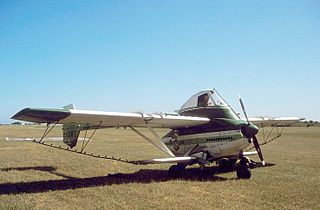
Luscombe Aircraft was a United States aircraft manufacturer from 1933 to 1950.
James Joseph "Jimmy" Ling was an American businessman and former head of Ling-Temco-Vought corporation. While at its helm, Ling used LTV funds to purchase a large number of corporations, and was one of the more famous of the 1960s conglomerate managers. As with other conglomerates such as ITT, Litton Industries, Teledyne, and Textron, higher interest rates and inflation destroyed LTV in the 1970s.

The Globe GC-1 Swift, also known as the Globe/Temco Swift, is a light, two-seat sport monoplane from the post-World War II period.

The RyanNavion is a single-engine, unpressurized, retractable gear, four-seat aircraft originally designed and built by North American Aviation in the 1940s. It was later built by Ryan Aeronautical Company and the Tubular Steel Corporation (TUSCO). The Navion was envisioned as an aircraft that would perfectly match the expected postwar boom in civilian aviation, since it was designed along the general lines of, and by the same company which produced the North American P-51 Mustang.

The Texas Engineering & Manufacturing Company (TEMCO), also known as Temco Aircraft Corporation, was a U.S.-based manufacturing company located in Dallas, Texas, USA. It is best known for eventually forming part of the conglomerate Ling-Temco-Vought.
The Aeronca Model 9 Arrow was a low-wing all-metal cabin monoplane with retractable landing gear. It was marketed to returning pilots from World War II and unveiled in 1947 but never went into production.

The Culver Dart was a 1930s American two-seat light monoplane aircraft produced by the Dart Aircraft Company.
The Culver Cadet is an American two-seat light monoplane aircraft, also once a radio-controlled drone, produced by the Culver Aircraft Company.

The Temco T-35 Buckaroo was designed in the late 1940s as an extremely low-cost trainer for commercial and military markets. Temco's failure to secure a United States Air Force order for the Buckaroo forced it to turn to non-U.S. governments to keep the production lines going, yet only a few export orders materialized.

The Stinson Voyager was a 1940s American light utility monoplane built by the Stinson Aircraft Company.

The Funk Model B was a 1930s American two-seat cabin monoplane designed by Howard and Joe Funk. Originally built by the Akron Aircraft Company later renamed Funk Aircraft Company.

The Bennett Aircraft Corporation Bi-motored Transport Commercial Number One (BTC-1) Executive was a 1930s American eight-seat light transport aircraft built by the Bennett Aircraft Corporation. In the ten-year span of its known life, the Bennett BTC-1 was identified in print by four different names: the Bennett, the Breese Bennett, the Bowlus Bennett and the Globe BTC-1.

The Timm N2T Tutor was an American training monoplane built by the Timm Aircraft Corporation, founded by Otto Timm for the United States Navy as the N2T-1.

The Meyers MAC-125 is a light sport aircraft developed in the United States in 1947, produced in a small series as the MAC-145.
Chilton Aircraft Ltd was a British aircraft design and manufacturing company of the late 1930s and 1940s.

Transavia Corporation was an Australian aircraft manufacturer active between 1965 and 1985.

The Eaglet 31 was a United States two-seat tandem ultra-light high-winged monoplane of the early 1930s. Intended as a low-cost aircraft, its limited production run relegated it to a footnote in aviation history.

The Johnson Rocket 185 was a 1940s American two seat cabin monoplane designed by Johnson and built at Fort Worth, Texas.

The Intercontinental Manufacturing Company (IMCO) was formed in the Dallas, Texas area in 1948 by Harold J. Silver and Robert F. Yonash, initially to fulfill an order from Argentina for tractors. IMCO soon changed focus to defense subcontracting, where it remains today.

The Temco D-16 is a 1950s twin engine civil aircraft from the United States. It was produced by conversion of a Ryan Navion to replace its single engine with two wing-mounted engines. It is commonly known as the Twin Navion, although that name is also often applied to a later similar conversion, the Camair 480.

















